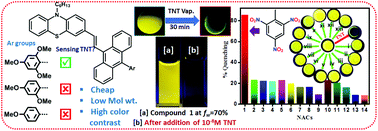Our official English website, www.x-mol.net, welcomes your
feedback! (Note: you will need to create a separate account there.)
An electron-rich small AIEgen as a solid platform for the selective and ultrasensitive on-site visual detection of TNT in the solid, solution and vapor states.
Analyst ( IF 3.6 ) Pub Date : 2020-01-02 , DOI: 10.1039/c9an02334h Banchhanidhi Prusti 1 , Manab Chakravarty 1
Analyst ( IF 3.6 ) Pub Date : 2020-01-02 , DOI: 10.1039/c9an02334h Banchhanidhi Prusti 1 , Manab Chakravarty 1
Affiliation

|
Promising research on AIEgen (aggregation-induced emission active fluorogens)-based sensors for the detection of explosives (mostly picric acid) is primarily dominated by polymeric molecules. However, herein, we report the ability of a recently developed anthracene-based electron-rich π-conjugate as a small and suitable AIEgen for the selective and sensitive detection of 2,4,6-trinitrotoluene (TNT) through fluorescence (PL) quenching. This fluorophore consists of trimethoxybenzene-linked anthranyl-π-phenothiazine, which is recognized as a significantly electron-rich AIEgen suitable for the selective detection of TNT detection. The detection of TNT was performed in the solid, liquid and vapor states using this AIEgen in the aggregate or solid-state. The detection limit in the solution state was measured to be 3.2 × 10-9 M. When this fluorophore was impregnated on a paper strip for on-site visual detection, TNT was detected up to the 10-14 M level by the naked eye using a 365 nm UV-torch. The paper strip was also successfully used to detect TNT in the vapour state. This application was further extended to detect TNT in field soil. The detection of TNT by replacing trimethoxybenzene in the fluorophore with dimethoxy or monomethoxy was a failure, indicating the requirement of an adequate electron-rich system. Unlike the previous report with static quenching as the main reason for TNT detection, our experimental observations demonstrated the participation of favorable photo-induced electron transfer (PET) between TNT and the fluorophore as the origin of the PL quenching.
中文翻译:

富含电子的小型AIEgen作为固态平台,可对固态,溶液态和蒸气态的TNT进行选择性和超灵敏的现场视觉检测。
用于检测爆炸物(主要是苦味酸)的基于AIEgen(聚集诱导的发射活性氟)传感器的有前途的研究主要由聚合物分子主导。但是,在这里,我们报道了最近开发的基于蒽的富电子π-共轭物作为通过荧光(PL)猝灭选择性和灵敏地检测2,4,6-三硝基甲苯(TNT)的合适的AIEgen的能力。该荧光团由三甲氧基苯连接的蒽基-π-吩噻嗪组成,其被认为是适用于选择性检测TNT的显着富电子的AIEgen。使用该AIEgen的聚集体或固态,以固态,液态和蒸气态进行TNT的检测。溶液状态下的检出限经测量为3.2×10-9M。当将该荧光团浸渍在纸条上以进行现场视觉检测时,使用365 nm UV炬用肉眼检测到高达10-14 M的TNT。纸条也成功地用于检测气相中的TNT。该应用程序进一步扩展为检测田间土壤中的TNT。通过用二甲氧基或单甲氧基取代荧光团中的三甲氧基苯来检测TNT失败,这表明需要有足够的富电子系统。与以前的报告中以静态猝灭为检测TNT的主要原因不同,我们的实验观察表明,在TNT和荧光团之间参与了有利的光诱导电子转移(PET),这是PL猝灭的起源。使用365 nm紫外炬用肉眼检测到高达10-14 M的TNT。纸带还成功地用于检测蒸气状态的TNT。该应用程序进一步扩展为检测田间土壤中的TNT。通过用二甲氧基或单甲氧基取代荧光团中的三甲氧基苯来检测TNT失败,这表明需要有足够的富电子系统。与以前的报告中以静态猝灭为检测TNT的主要原因不同,我们的实验观察表明,在TNT和荧光团之间参与了有利的光诱导电子转移(PET),这是PL猝灭的起源。使用365 nm紫外炬用肉眼检测到高达10-14 M的TNT。纸条也成功地用于检测气相中的TNT。该应用程序进一步扩展为检测田间土壤中的TNT。通过用二甲氧基或单甲氧基取代荧光团中的三甲氧基苯来检测TNT失败,这表明需要有足够的富电子系统。与以前的报告中以静态猝灭为检测TNT的主要原因不同,我们的实验观察表明,在TNT和荧光团之间参与了有利的光诱导电子转移(PET),这是PL猝灭的起源。通过用二甲氧基或单甲氧基取代荧光团中的三甲氧基苯来检测TNT失败,这表明需要有足够的富电子系统。与以前的报告中以静态猝灭为检测TNT的主要原因不同,我们的实验观察表明,在TNT和荧光团之间参与了有利的光诱导电子转移(PET),这是PL猝灭的起源。通过用二甲氧基或单甲氧基取代荧光团中的三甲氧基苯来检测TNT失败,这表明需要有足够的富电子系统。与以前的报告中以静态猝灭为检测TNT的主要原因不同,我们的实验观察表明,在TNT和荧光团之间参与了有利的光诱导电子转移(PET),这是PL猝灭的起源。
更新日期:2020-03-03
中文翻译:

富含电子的小型AIEgen作为固态平台,可对固态,溶液态和蒸气态的TNT进行选择性和超灵敏的现场视觉检测。
用于检测爆炸物(主要是苦味酸)的基于AIEgen(聚集诱导的发射活性氟)传感器的有前途的研究主要由聚合物分子主导。但是,在这里,我们报道了最近开发的基于蒽的富电子π-共轭物作为通过荧光(PL)猝灭选择性和灵敏地检测2,4,6-三硝基甲苯(TNT)的合适的AIEgen的能力。该荧光团由三甲氧基苯连接的蒽基-π-吩噻嗪组成,其被认为是适用于选择性检测TNT的显着富电子的AIEgen。使用该AIEgen的聚集体或固态,以固态,液态和蒸气态进行TNT的检测。溶液状态下的检出限经测量为3.2×10-9M。当将该荧光团浸渍在纸条上以进行现场视觉检测时,使用365 nm UV炬用肉眼检测到高达10-14 M的TNT。纸条也成功地用于检测气相中的TNT。该应用程序进一步扩展为检测田间土壤中的TNT。通过用二甲氧基或单甲氧基取代荧光团中的三甲氧基苯来检测TNT失败,这表明需要有足够的富电子系统。与以前的报告中以静态猝灭为检测TNT的主要原因不同,我们的实验观察表明,在TNT和荧光团之间参与了有利的光诱导电子转移(PET),这是PL猝灭的起源。使用365 nm紫外炬用肉眼检测到高达10-14 M的TNT。纸带还成功地用于检测蒸气状态的TNT。该应用程序进一步扩展为检测田间土壤中的TNT。通过用二甲氧基或单甲氧基取代荧光团中的三甲氧基苯来检测TNT失败,这表明需要有足够的富电子系统。与以前的报告中以静态猝灭为检测TNT的主要原因不同,我们的实验观察表明,在TNT和荧光团之间参与了有利的光诱导电子转移(PET),这是PL猝灭的起源。使用365 nm紫外炬用肉眼检测到高达10-14 M的TNT。纸条也成功地用于检测气相中的TNT。该应用程序进一步扩展为检测田间土壤中的TNT。通过用二甲氧基或单甲氧基取代荧光团中的三甲氧基苯来检测TNT失败,这表明需要有足够的富电子系统。与以前的报告中以静态猝灭为检测TNT的主要原因不同,我们的实验观察表明,在TNT和荧光团之间参与了有利的光诱导电子转移(PET),这是PL猝灭的起源。通过用二甲氧基或单甲氧基取代荧光团中的三甲氧基苯来检测TNT失败,这表明需要有足够的富电子系统。与以前的报告中以静态猝灭为检测TNT的主要原因不同,我们的实验观察表明,在TNT和荧光团之间参与了有利的光诱导电子转移(PET),这是PL猝灭的起源。通过用二甲氧基或单甲氧基取代荧光团中的三甲氧基苯来检测TNT失败,这表明需要有足够的富电子系统。与以前的报告中以静态猝灭为检测TNT的主要原因不同,我们的实验观察表明,在TNT和荧光团之间参与了有利的光诱导电子转移(PET),这是PL猝灭的起源。









































 京公网安备 11010802027423号
京公网安备 11010802027423号